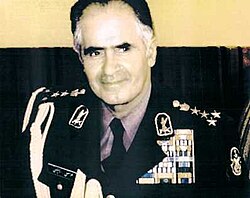Gholam Ali Oveisi
|
Commander of the Imperial Army Gholam-Ali Oveissi |
|
|---|---|

General Gholam-Ali Oveissi
|
|
| Born |
16 April 1918 Qom, Iran |
| Died | 7 February 1984 (aged 65) Paris, France |
| Buried at | Père Lachaise |
| Allegiance | Iran |
| Service/branch | Imperial Iranian Army |
| Years of service | 1934–1979 |
| Rank | General (Four Star) |
| Commands held | Commander of the Iranian Imperial Army |
| Awards | see Medals |
| Relations | Sharareh Sarmad Oveissi(Wife) Mohammad-Reza Oveissi(son) Ali-Reza Oveissi (son) Fereshteh Oveissi (daughter) Hossein Oveissi (son) Shahryar Oveissi (son) Sharafat Oveissi (Deceased first-wife) |
General (Arteshbod) Gholam-Ali Oveissi was an Iranian four-star general and the Chief Commander of the Imperial Iranian Armed Forces under Mohammad Reza Pahlavi. He was the last general to head the Imperial Army of Iran. He is regarded as one of the most powerful and adept military generals in Iran’s modern history.
General Oveissi was born in 1918 in the city of Qhom. He came from a large prominent family with a long military and political history. Most of the members of his family including his brothers and sisters served in Government office. Oveissi’s family from his father’s lineage goes back to Shah Qara Yusuf Muhammad, the ruler of the Ghara Ghoyonlu dynasty (Black Seep Turkomans) and descends through Uzun Hassan when he defeated Jahan Shah in a battle near the sanjak of Çapakçur in present day eastern Turkey on 30 October (or 11 November), 1467, resulting in a merger of the Ghara Ghoyonlu and the Agh Ghoyunlu dynasty (White Sheep Turkomans). He is a direct descendant of Eskandar Beik Torkaman,the Minister, head of army (Iraq campaign) and personal advisor to Shah Abbas the Great. On his mother's side he was the grandson of Hossein Ali Mirza, the eldest son of Mohammad Ali Shah Qajar.
Oveissi received his diploma from Iran's Military High School. He attended the Officer’s Faculty in 1938 continuing his military training in the Military Academy in Tehran and finishing in 1951. He attended the Military organization in Fort Meyers, Virginia and Fort Leavenworth Kansas in 1959.
From 1938-1939 he was chosen to command the Military Section of the 7th and 13th regiments positioned in Fars Province and replaced the commander of the 6th regiment from 1940-1941. From 1941 – 1943 he replaced the military commander of Fars Province, section 13.
From 1940-1960 he was chief of the military faculty in Tehran. After 1955 his military career progressed very rapidly.
On 12 September 1954, he became a full colonel and served with that rank until 1960 when he was promoted to general in the Royal Iranian Army.
From 1958-1960 he participated actively in the military court prosecution of communist officers.
...
Wikipedia
